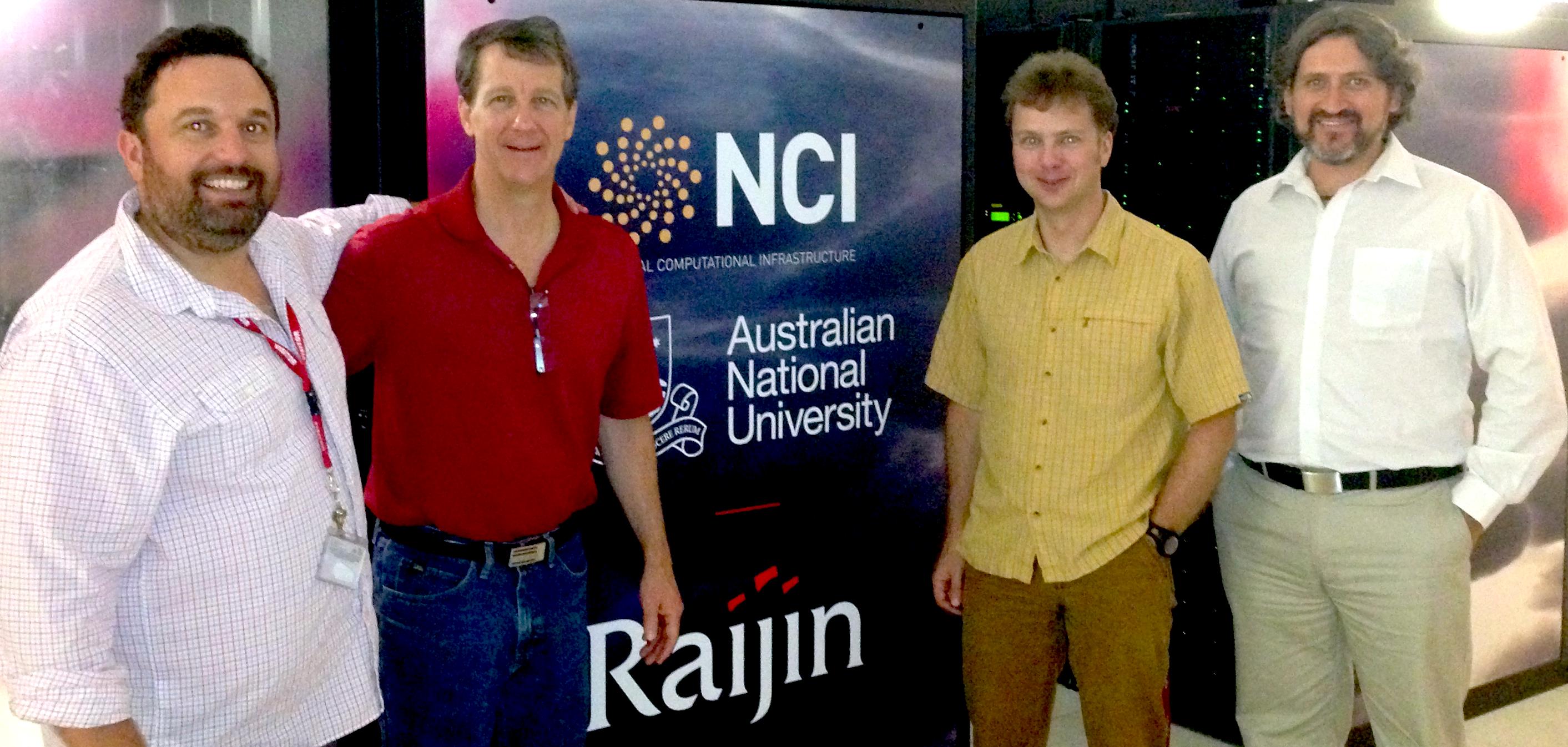DART into the NCI: towards an ecosystem data assimilation system for Australia

by Luigi Renzullo & Brad Evans
A comprehensive and integrated understanding of the terrestrial water, energy and carbon cycles requires four things: an observational database, a biophysical modelling framework, mathematical integration know-how, and the computer grunt to bring it all together. Recent Australian-US collaboration has progressed the development of a research community focused ecosystem modelling and observation integration system for Australian on one of the nation’s top computing facilities.

Installing and testing DART on NCI supercomputer Raijin: (left to right) Dr Brad Evans (eMAST director, Macquarie University) , Tim Hoar (NCAR, USA), Dr Andy Fox (NEON, USA) and Dr Luigi Renzullo (CSIRO).
Researchers from CSIRO, Macquarie University and the National Computing Infrastructure (NCI) teamed up with US collaborators to install and run the Data Assimilation Research Tested (DART) on NCI’s supercomputer (Raijin) and coupled to it Australia’s Community Atmosphere Biosphere Land Exchange (CABLE) land surface model. The endeavour marks significant progress toward the vision of the Ecosystem Modelling and Scaling Infrastructure (eMAST) facility under the Terrestrial Ecosystem Research Network (TERN) to develop Australia’s first modelling and data integration system for ecosystem science and monitoring at unparalleled scales in space and time. The system will bring together a range of disparate ecological observations from ground- and space-based sensing networks into CABLE’s modelling framework.

Hard at work in an NCI office. The team were often found huddled around the laptop computer screen of DART guru, Tim Hoar.
For two weeks in February this year, US researchers Tim Hoar (National Center for Atmospheric Research, NCAR) and Dr Andy Fox (National Ecologic Observatory Network, NEON) worked with Dr Brad Evans (eMAST Director, Macquarie University) and Drs Luigi Renzullo, Cathy Trudinger and Ying-Ping Wang (CSIRO) to set up and test DART on NCI’s Raijin computing cluster. Thanks to NCI National Facility Associate Director Dr Ben Evans, the team were up and running on from day 1 on what is clearly state-of-the art computer hardware, in Australia and ranks among the to 500 list worldwide.
The team, representing a subset of Australia’s leaders in land surface modelling and data assimilation, are committed to the community spirit that began with CABLE development and now extends via eMAST to the sharing of observational data (including flux tower, field data and a large range of satellite remote sensing products) and exposing the land surface products generated to the wider research community. Key outputs generated by the system at 1-km resolution for the whole country will include root-zone moisture (for drought monitoring), gross primary production (for carbon stock assessment), and stomatal conductance (as the bridge between water and carbon cycles).
 Dr Cathy Trudinger (CSIRO) working with Tim Hoar on the coupling of CABLE to DART.
Dr Cathy Trudinger (CSIRO) working with Tim Hoar on the coupling of CABLE to DART.
The DART package provides a range of ensemble-based filtering techniques to assimilate both point and spatial observations into CABLE, including variants of the Kalman filter and particle filter. DART offers a convenient “package” for evaluating different assimilation techniques for CABLE, and will be used (along with NASA’s Land Information System) in a methods intercomparison planned for later this year and driven by the OzEWEX Working Group on Data Assimilation, but will also engage working groups on Model Evaluation and Benchmarking and Vegetation Processes. Outcomes of the intercomparison will be reporting on the accuracy and computational feasibility of the various data assimilation methods for CABLE, and importantly will provide indicative resourcing requirements for large-scale / continental data assimilation need for scoping operational systems. The team recognises the enormous computational challenges of assimilating the variety of observations into CABLE and the generated model estimates (and uncertainty) at daily and 1-km resolution across Australia. The endeavour will not be possible were it not for the NCI, not least of all because it remains the only computing environment accessible to researchers from government institutions and universities alike.
Further information contact: Dr Luigi Renzullo or Dr Brad Evans
